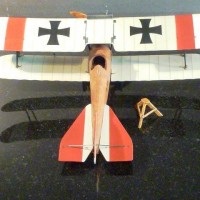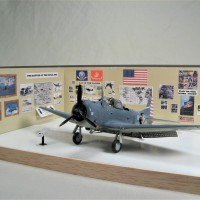War Above the Trenches: Phönix D.1
The Aircraft
The Austro-Hungarian Navy (Kaiserliche und Königliche Kriegsmarine) was the naval force of the Dual Empire. Its name was commonly abbreviated as K.u.K. Kriegsmarine, and by the outbreak of war in 1914 it already had its own aviation corps: the K.u.K. Seefliegerkorps (Imperial and Royal Naval Air Corps), which used both German aircraft and Austro-Hungarian variants, including various Fokker types, the Hansa-Brandenburg B.I and D.I, the Aviatik D.I, the Albatros D.III, the Phönix D.I and the Lohner L.
The Phönix D.I was the second design developed by the Phönix Flugzeug-Werke based on the Hansa-Brandenburg D.I which it had produced under licence. The Phönix D.I was a single-seat biplane fighter with improvements over the original Hansa-Brandenburg design.
A characteristic of the D.I was the so-called "Sparmann wing cellule" with its unique inward-leaning wing struts. It was the design of Diplom-Ingenieur Edmund Sparmann who, after pre-war work and later service on the Russian front, was assigned to Albatros in 1916, where he became involved in designing aircraft structures.
A prototype was first flown in 1917 and proved to be fast but difficult to handle, yet because of the urgent need for fighters the D.I entered production. In later months, a D.II was introduced with balanced elevators and balanced ailerons on the upper wings. A further development was the D.III which had balanced ailerons on both wings and a more powerful 230 hp (172 kW) Hiero in-line engine. The last of 158 aircraft of all three types was delivered on 4 November 1918.
The Model
This is the 1/48 Special Hobby limited-run kit of the Phönix D.I. The kit includes a small PE fret, a few nicely moulded resin additions and markings for three aircraft. The machine modelled here is A.114, K.u.K. Kriegsmarine (Seefliegerkorps), based at Altura (Pula airfield) in Spring/Summer 1918.
The other two sets of markings are also for machines based at the same airfield at this time, all distinguished by their colourful red-and-white-striped wing/empennage livery. The fuselage camouflage is typical of the type, that is, a light or creamy brown mottled-over with a medium brown. The fuselage underside was natural plywood.
A useful reference source for this project was Windsock Datafile 31,"Phönix D.I-II" by Peter M Grosz.















Another beautiful piece of modeling, Rob. 🙂
Cheers, Craig.
Very good looking Phönix, Rob. You have found a recepy to bring out the colours of wood and a feeling of fragility. Sweden bought Phönix DII after the WW1 and Herr Dipl Ing Sparmann was active in Sweden constructing aircraft between the wars, he died in 1951 in Stockholm.
Yes, a testament to the quality of this aircraft that Sweden bought only the Phönix D type and the Albatros III post-War from which to develop their air service.
Some photos http://www.avrosys.nu/aircraft/Flygkomp/23Phoenix-2.htm Check out the last photo of the one Sparmann allegedly used in Stockholm in 1919, still in Austrian colours?
Love the Swedish stuff.
Great looking Phönix, Rob!
Thanks, Jeff.
Rob, This is really nice. A very attractive paint scheme and very well done, I like it a lot !
Thanks, Terry. I thought it might look a bit cumbersome but instead it has a nice quality about it, I think.
Great job!
Cheers, Robert.
Rob, do you have a 'master plan' for all these (beautiful) biplanes you've been making? Just wondering if you have a display in mind or overall project you are working on? They must make fantastic looking collection...
Only the “War Above the Trenches” theme, and with more obscure subjects in quarter scale.
Everything about this Phönix is really nice - construction, painting, rigging. Overall excellent.
Cheers, Tom.
Great job! Assembly, painting - all at a very high level.
Thanks. A bit more of a push to get the quality with this plastic kit than with previous resin examples, surprisingly.
Brilliant! Another masterpiece Rob!
Cheers, Greg. Very kind.